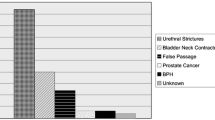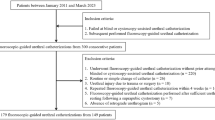Abstract
A difficult urethral catheterization (DUC) occurs when a urethral catheter cannot be advanced into the bladder after one or more attempts. Depending on the practice setting, using a 16–18 F Coudè catheter followed by a 12 F silicone catheter can solve most DUC cases. When catheterizing by an experienced practitioner fails, it is recommended to attempt placing a glidewire blindly. If urethral dilation is needed, using small (<14Fr) ureteral access sheaths is usually all is needed. Cystoscopy will be necessary for a small percentage of cases.
Access this chapter
Tax calculation will be finalised at checkout
Purchases are for personal use only
Similar content being viewed by others
References
Athanassopoulos A, Liatsikos EN, Barbalias GA. The difficult urethral catheterization: use of a hydrophilic guidewire. BJU Int. 2005;95(1):192.
Beaghler M, Grasso 3rd M, Loisides P. Inability to pass a urethral catheter: the bedside role of the flexible cystoscope. Urology. 1994;44(2):268–70.
Chiou RK, Aggarwal H, Chen W. Glidewire-assisted Foley catheter placement: a simple and safe technique for difficult male catheterization. Can Urol Assoc J. 2009;3(3):189–92.
Freid RM, Smith AD. The glidewire technique for overcoming urethral obstruction. J Urol. 1996;156(1):164–5.
Lachat ML, Moehrlen U, Bruetsch HP, Vogt PR. The seldinger technique for difficult transurethral catheterization: a gentle alternative to suprapubic puncture. Br J Surg. 2000;87(12):1729–30.
Mistry S, Goldfarb D, Roth DR. Use of hydrophilic-coated urethral catheters in management of acute urinary retention. Urology. 2007;70(1):25–7.
Villanueva C, Hemstreet 3rd GP. Difficult male urethral catheterization: a review of different approaches. Int Braz J Urol. 2008;34(4):401–11.
Villanueva C, Hossain SG, Nelson CA. Silicone catheters may be superior to latex catheters in difficult urethral catheterization after urethral dilation. J Endourol. 2011;25(5):841–4.
Zammit PA, German K. The difficult urethral catheterization: use of a hydrophilic guidewire. BJU Int. 2004;93(6):883–4.
Author information
Authors and Affiliations
Corresponding author
Editor information
Editors and Affiliations
Rights and permissions
Copyright information
© 2017 Springer-Verlag London
About this chapter
Cite this chapter
Villanueva, C. (2017). Difficult Urethral Catheterization. In: Rané, A., Turna, B., Autorino, R., Rassweiler, J. (eds) Practical Tips in Urology. Springer, London. https://doi.org/10.1007/978-1-4471-4348-2_12
Download citation
DOI: https://doi.org/10.1007/978-1-4471-4348-2_12
Published:
Publisher Name: Springer, London
Print ISBN: 978-1-4471-4347-5
Online ISBN: 978-1-4471-4348-2
eBook Packages: MedicineMedicine (R0)




